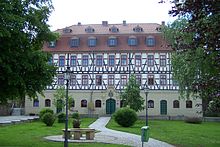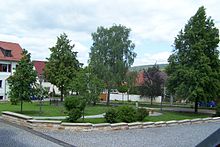Bischofroda Castle
The Bischofroda Castle is a castle in the municipality Bischofroda in Wartburgkreis . It is located in the western part of the village, immediately south of the village church. The castle is a protected architectural monument .
history
The area around Bischofroda has been a Catholic enclave since the 16th century. The Archdiocese of Mainz asserted against the claims of the Saxon dukes that they were contractually bound by a condominium that had been in force since the 14th century through the Ganerbschaft Treffurt with the Landgrave of Hesse and the Archdiocese of Mainz to preserve the existing borders and dominions. The place Bischofroda and the associated provost office Zella were subordinated to the Peterskloster in Erfurt and had been able to bind a branch of the Knights of Creuzburg to themselves as patrons , which died out with the death of Colonel Georg Ernst von Creuzburg in 1742. The previous castle was a considerable in size, but in the design simple half-timbered building and served the Creuzburgers as an annex, as they initially lived in the Wasserburg Schloss Berka in the neighboring village of Berka in front of the Hainich .
Because of the small size of the Bischofroda exclave , the new administrator could only dispose of a small amount of tax money, and today's castle was also built as the main building of the Bischofroda estate. The building materials were obtained from quarries in Madelungen , 5 kilometers away . The main portal is adorned with the episcopal coat of arms as a reference to the suzerainty of the Erfurt Petersstift. Tenants took over the management of the property, which had been converted into a chamber property: Johann Philipp Kümmel managed the Bischofroda property from 1773 to 1796, followed by Mr. Goldammer . After the Napoleonic occupation of Erfurt , the areas in Thuringia belonging to the Archdiocese of Mainz were expropriated. The ownership rights to Gut Bischofroda were transferred to the official administration in Creuzburg , and Napoleon gave the also expropriated Probsteizella to a French general as an award. The third tenant was Friedrich Hähnert from 1841 to 1853, followed by his son Theodor Hähnert from 1853 to 1880. The last estate manager was Schambach economist. After his retirement in 1901, the estate was dissolved and a cooperative formed by 86 Bischofrodaers had The contract for the property was awarded, the agricultural corridors were divided according to the contract. A Hessian Colonel Ernst von Kietzell acquired the palace building in 1902 as a retirement home. The family lived in the house until 1941 and sold the building to a property management company of the Reich government. From 1941 to 1945 the castle served as a training center for the Reich Labor Service and, most recently, as a camp for a group of Belgian prisoners of war. After the end of the war, the Bischofroda community received the building. The numerous rooms were used as apartments and administration rooms, and at times the kindergarten and classrooms of the primary school were also housed in the castle. After the fall of the Wall, the castle was extensively renovated and is still the seat of the Bischofroda municipal administration.
literature
- W. Böttger: 900 years Bischofroda in 2004 , community Bischofroda (ed.), Printing and publishing house Frisch, Eisenach 2004
Web links
Coordinates: 51 ° 3 ′ 23.2 " N , 10 ° 21 ′ 41.8" E




